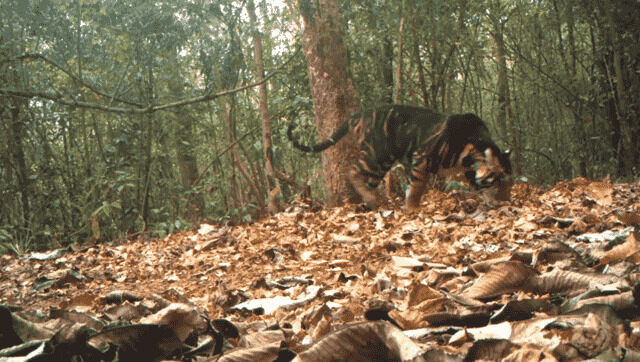A digital illustration of the black tiger has surfaced online. Shared by graphic designer Sudarshan Shaw, the illustration features the pseudo-melanistic tiger walking in a forest while another tiger rests on the other side. Have a look at the illustration here:
Digital illustration of a pseudo- melanistic tiger from Similipal National park, Odisha.
— Sudarshan Shaw (@Sudarshanshaw93) July 30, 2022
Folk representation done for a scientific paper by NCBS.#blacktiger #pseudomelanistictiger #tiger #similipal #odisha pic.twitter.com/qJq1VSXnfI
The tweet mentioned that the image was a digital illustration of a pseudo-melanistic tiger in Similipal National park, Odisha. The illustration was a folk representation done for a scientific paper by NCBS, it further read. This was in response to a clip tweeted by IFS officer Susanta Nanda where a tiger could be seen marking its territory on International Tiger Day.
Tigers are symbol of sustainability of India’s forests…
— Susanta Nanda IFS (Retd) (@susantananda3) July 29, 2022
Sharing an interesting clip of a rare melanistic tiger marking its territory on international Tigers day.
From a Tiger Reserve poised for recovery of an isolated source population with a very unique gene pool. Kudos🙏🙏 pic.twitter.com/FiCIuO8Qj4
The tweet mentioned that tigers were a symbol of sustainability of India’s forests and that the clip was from a Tiger Reserve poised for recovery of an isolated source population that possessed a unique gene pool. Kaswan shared the clip and wrote that the black tigers of India are pseudo - melanistic tigers found in Simlipal. These black cats had a genetic mutation and were highly rare. The officer tagged Susanta Nanda in his post.
The black tigers of #India. Do you know there are pseudo- melanistic tigers found in Simlipal. They are due to genetic mutation & highly rare. @susantananda3 pic.twitter.com/oEMCqRYKiF
— Parveen Kaswan, IFS (@ParveenKaswan) July 30, 2022
As per a study done by a team of scientists from the National Centre for Biological Sciences (NCBS), Bengaluru, a single genetic mutation in these tigers causes the black stripes to broaden into the tawny background. This variant is distinguished by broadened and fused stripes and is called pseudo-melanism. It is different from melanism that is characterised by unusually high deposition of a dark pigment called melanin. The genetic variations happen spontaneously, but are not frequent. Earlier, a video was shared by Indian Forest Service (IFS) officer Susanta Nanda showing a tiger crossing the road. Sharing the video, Nanda had termed the visual as a ‘Magical Monsoon’. In the video, the tiger could be seen slowly crossing a road and walking into a jungle, highlighting the need to focus on the construction of mitigation structures for wild animals. Read all the Latest News , Trending News , Cricket News , Bollywood News , India News and Entertainment News here. Follow us on Facebook, Twitter and Instagram.


)

)
)
)
)
)
)
)
)



